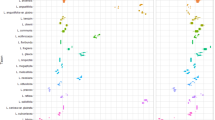Abstract
The seed coat structure of all 13 species ofCrossostylis was studied to contribute to an understanding of species delimitation and relationships within the genus. The mature seed coat is relatively uniform and consistently constructed mainly by a well-developed exotesta and a well-developed fibrous exotegmen. The species differ in the thickness of the exotesta and exotegmen, the anatomy of exotestal cells, the presence and absence of persistent mesotesta, and so forth. On the basis of comparisons of these characters, close relationships are suggested in the species groups such as:Crossostylis banksiana andC. cominsii; C. biflora, C. raiateensis andC. multiflora; C. gandiflora, C. sebertii andC. imera; and five species in the Fiji Islands. These relationships except for those of Fijian five species are also supported by cladistics as their common characters are evaluated as synapomorphy. Species-level separation ofC. banksiana, C. pedunculata andC. raiateensis each from the closest species is doubted based on the results of seed coat structure.
Similar content being viewed by others
References
Brongniart, M.H.A., andA. Gris. 1870. Diverses plantes Nouvelles ou peu connues de la Nouvelle-Calédonie. Ann. Sc. Nat. Ser. 5,13: 340–404.
Corner, E.J.H. 1976. The Seeds of Dicotyledons. vol. 1 and 2. Cambridge Univ. Press, Cambridge.
Guillaumin, A. 1931. Contribution to the flora of the New Hebrides. J. Arnold Arb.12: 221–264.
Hou, D. andC.G.G.J. van Steenis. 1963.Crossostylis.In C.G.G.J. van Steenis, ed., Pacific Plants Areas. Vol. 1, pp. 290–291. Manila Bureau of Printing, Manila.
Juncosa, A.M. andH. Tobe. 1988. Embryology of tribe Gynotrocheae (Rhizophoraceae) and its developmental and systematic implications. Ann. Missouri Bot. Gard.75: 1410–1424.
— andP.B. Tomlinson. 1988. Systematic comparison and some biological characters of Rhizophoraceae and Anisophylleaceae. Ann. Missouri Bot. Gard.75: 1296–1318.
Moore, J.W. 1963. Notes on Raiatean flowering plants. Bishop Mus. Bull.226: 1–36.
Schmid, R. 1986. On Cornerian and other terminology of angiospermous and gymnospermous seed coats: historical perspective and terminological recommendations. Taxon35: 476–491.
—, andM.D. Turner. 1977. Contrad 70, an effective softener of herbarium material for anatomical study. Taxon26: 551–552.
Smith, A.C. 1952. Studies of pacific island plants, XI. Further notes on Fijian flowering plants. J. Arnold Arb.33: 97–118.
— 1981. Flora Vitiensis Nova. Vol. 2. Pacific Tropical Botanical Garden, Lawai.
Tobe, H. andP.H. Raven. 1988. Seed morphology and anatomy of Rhizophoraceae, inter- and infrafamilial relationships. Ann. Missouri Bot. Gard.75: 1319–1342.
Author information
Authors and Affiliations
Rights and permissions
About this article
Cite this article
Setoguchi, H., Tobe, H. & Ohba, H. Seed coat anatomy ofCrossostylis (Rhizophoraceae): its evolutionary and systematic implications. Bot Mag Tokyo 105, 625–638 (1992). https://doi.org/10.1007/BF02489436
Received:
Accepted:
Issue Date:
DOI: https://doi.org/10.1007/BF02489436




